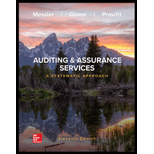
EBK AUDITING & ASSURANCE SERVICES: A SY
11th Edition
ISBN: 9781260687668
Author: Jr
Publisher: MCGRAW-HILL LEARNING SOLN.(CC)
expand_more
expand_more
format_list_bulleted
Question
Chapter 17, Problem 17.22P
To determine
Concept Introduction:
To discuss:The audit procedure that CPA should follow with respect to the existence of loss contingence arising from litigation, claims, and assessment
Expert Solution & Answer
Want to see the full answer?
Check out a sample textbook solution
Students have asked these similar questions
Please help with questions
Please help with questions
Help with problems
Chapter 17 Solutions
EBK AUDITING & ASSURANCE SERVICES: A SY
Ch. 17 - Prob. 17.1RQCh. 17 - Prob. 17.2RQCh. 17 - Prob. 17.3RQCh. 17 - Prob. 17.4RQCh. 17 - Prob. 17.5RQCh. 17 - Prob. 17.6RQCh. 17 - Prob. 17.7RQCh. 17 - Prob. 17.8RQCh. 17 - Prob. 17.9RQCh. 17 - Prob. 17.10RQ
Ch. 17 - Prob. 17.11RQCh. 17 - Prob. 17.12RQCh. 17 - Prob. 17.13MCQCh. 17 - Prob. 17.14MCQCh. 17 - Prob. 17.15MCQCh. 17 - Prob. 17.16MCQCh. 17 - Prob. 17.17MCQCh. 17 - Prob. 17.18MCQCh. 17 - Prob. 17.19MCQCh. 17 - Prob. 17.20MCQCh. 17 - Prob. 17.21MCQCh. 17 - Prob. 17.22PCh. 17 - Prob. 17.23PCh. 17 - Prob. 17.24PCh. 17 - Prob. 17.25PCh. 17 - Prob. 17.26PCh. 17 - Prob. 17.27PCh. 17 - Prob. 17.28P
Knowledge Booster
Similar questions
arrow_back_ios
SEE MORE QUESTIONS
arrow_forward_ios
Recommended textbooks for you
 Auditing: A Risk Based-Approach (MindTap Course L...AccountingISBN:9781337619455Author:Karla M Johnstone, Audrey A. Gramling, Larry E. RittenbergPublisher:Cengage Learning
Auditing: A Risk Based-Approach (MindTap Course L...AccountingISBN:9781337619455Author:Karla M Johnstone, Audrey A. Gramling, Larry E. RittenbergPublisher:Cengage Learning Auditing: A Risk Based-Approach to Conducting a Q...AccountingISBN:9781305080577Author:Karla M Johnstone, Audrey A. Gramling, Larry E. RittenbergPublisher:South-Western College Pub
Auditing: A Risk Based-Approach to Conducting a Q...AccountingISBN:9781305080577Author:Karla M Johnstone, Audrey A. Gramling, Larry E. RittenbergPublisher:South-Western College Pub

Auditing: A Risk Based-Approach (MindTap Course L...
Accounting
ISBN:9781337619455
Author:Karla M Johnstone, Audrey A. Gramling, Larry E. Rittenberg
Publisher:Cengage Learning

Auditing: A Risk Based-Approach to Conducting a Q...
Accounting
ISBN:9781305080577
Author:Karla M Johnstone, Audrey A. Gramling, Larry E. Rittenberg
Publisher:South-Western College Pub
